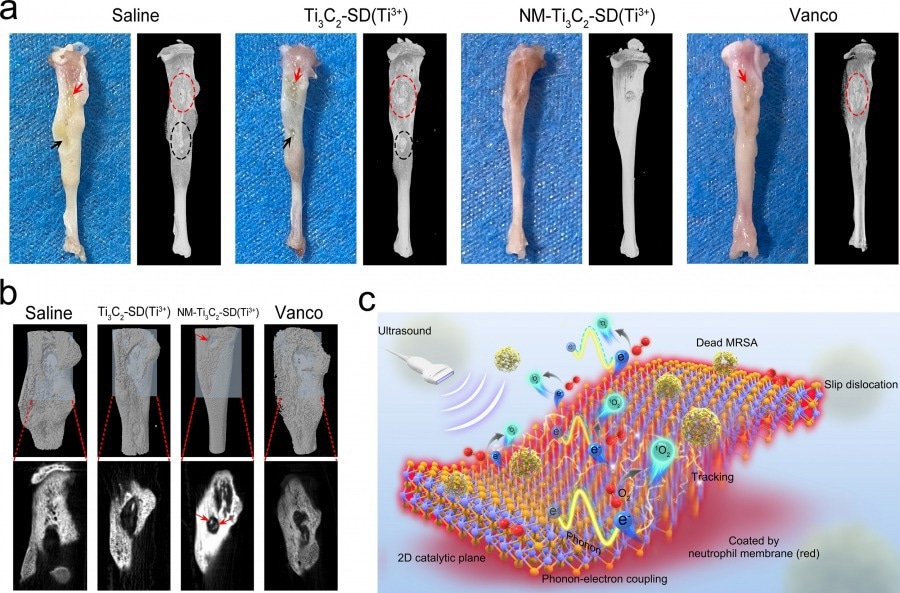A non-invasive and non-antibiotic technology has been developed by a research team at the University of Hong Kong (HKUMed) under the direction of Professor Kelvin Yeung Wai-kwok from the Department of Orthopedics and Traumatology, School of Clinical Medicine, LKS Faculty of Medicine, to efficiently minimize methicillin-resistant Staphylococcus aureus (MRSA) infection in bony tissue.

Image Credit: University of Hong Kong
When stimulated by ultrasound, the new antibacterial nano-sheets have the ability to emit reactive oxygen species (ROS). The nano-sheets can aggressively catch the MRSA bacteria that are deeply embedded in bone tissue and successfully eradicate 99.72% ± 0.03% because of the engulfment of the neutrophil membrane (NM).
Background
Osteomyelitis, a type of bone infection, is caused by bacteria, fungi, or other microorganisms and occurs in the bone or bone marrow. MRSA is the most prevalent bacterium that causes this disease.
Amputation or even sepsis that could prove fatal can result from severe infections in people. Clinically, the removal of the diseased bone or tissue and the administration of antibiotics are the usual treatments for bone tissue infections.
Antibiotic overuse, however, not only impairs the host’s innate immune system but also eventually leads to the rise of infections that are resistant to antibiotics. Recently, antibiotic-free phototherapy, including photodynamic and photothermal therapies, has been used to treat bacterial infections.
However, due to its weak penetrating strength, traditional phototherapy is unable to treat deep tissue infections, such as bone. The penetrating capability of ultrasound to human tissues is therefore viewed as an alternative antibiotic-free method.
Research Method and Findings
Ti3C2-SD(Ti3+) nano-sheets are a novel two-dimensional (2D) sonosensitizer created by the HKUMed research team. The efficiency of ROS formation is constrained in a traditional sonosensitizer that is structured in zero dimensions.
When an ultrasonic signal triggers the novel 2D sonosensitizer, which has a large number of planar catalytic sites, a significant amount of ROS can be produced.
The NM-Ti3C2-SD(Ti3+) nano-sheets (NM-nano-sheets) are able to actively track down the MRSA bacteria in bone tissue subjected to ultrasonic stimulation after being adorned with the neutrophil membrane (NM). In an animal model, new nano-sheets significantly outperformed antibiotic treatment (Vanco) in eliminating MRSA bacteria from the bone.
Once the infection in the bony tissue has been managed, the NM-nano-sheets can help reduce tissue inflammation and aid in bone healing. Additionally, there are no serious bio-safety concerns with the NM-coated nano-sheets.
Our design has achieved a qualitative leap in which the ROS catalytic site in sonosensitizer has transformed from zero-dimensional to two-dimensional. This invention can remarkably increase the production of bactericide (ROS). We may also consider applying this invention to the post-operation bacterial infection commonly seen in bone cancer patients or the patients with cystitis and peritonitis in the future.
Kelvin Yeung Wai-kwok, Professor, Department of Orthopedics and Traumatology, School of Clinical Medicine, LKS Faculty of Medicine, University of Hong Kong
About the Research Team
Professor Kelvin Yeung Wai-kwok, from the Department of Orthopedics and Traumatology at the School of Clinical Medicine at HKUMed, led the study. The first author is postdoctoral fellow Dr Mao Congyang. Spinal abnormalities, orthopedic biomaterials, musculoskeletal tissue engineering, 3D bio-printing, and anti-bacterial nanomaterials are among the areas of study pursued by Professor Yeung’s group.
Acknowledgements
, Innovation and Technology Fund Partnership Research Programme (#PRP/030/30FX), The National Science Fund for Distinguished Young Scholars (No. 51925104), Shenzhen Science and Technology Funding (Nos. JCYJ20210324120012034 and JCYJ20210324120009026), National Key R&D Programs of China (R&D#2018YFA0703100), General Research Fund of Hong Kong Research Grant Council (Nos. 17214516 and 17207719), Hong Kong Health and Medical Research Fund (Nos.19180712, 20190422 and 21200592) and Shenzhen’s Sanming Project of Medicine– ’Team of Excellence in Spinal Deformities and Spinal Degeneration’ Diseases (SZSM201612055) supported the study jointly.
Journal Reference
Mao, C., et al. (2023) Realizing Highly Efficient Sonodynamic Bactericidal Capability through the Phonon–Electron Coupling Effect Using Two-Dimensional Catalytic Planar Defects. Advanced Materials. doi:10.1002/adma.202208681